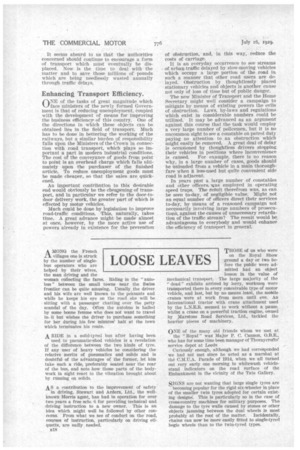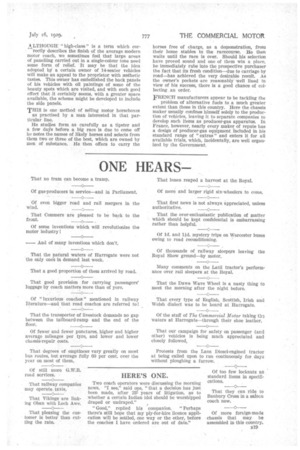LOOSE LEAVES
Page 44

Page 45

If you've noticed an error in this article please click here to report it so we can fix it.
A MONG the French villages one is struck by the number of singlebus operators who are helped by their wives, the man driving and the woman collecting the fares. Riding in the " autobus " between the small towns near the Swiss frontier can be quite amusing. Usually. the driver and his wife are well known to the peasants and while he keeps his eye on the road she will be sitting with a passenger chatting over the petty scandal of the day. Often the autobus is hailed by some bonne femme who does not want to travel in• it but wishes the driver to purchase something for her during his few minutes' halt at the town which terminates his route.
A RIDE in a solid-tyred bus after having been used to pneumatic-shod vehicles is a revelation of the difference between the two kinds of tyre. If any user of heavy vehicles be considering the relative merits of pneumatics and solids and is doubtful of the advantages of the former, let him take such a ride, preferably seated near the rear of the bus, and note how those parts of the bodywork in sight react to the vibration brought about by running on solids.
AS a contribution to the improvement of safety • in driving, Stewart and Ardern, Ltd., the wellknown Morris agent, has had in operation for over two years a free schc .1 for providing technical and driving instruction to a new owner. This is an idea which might well be followed by other concerns. From what we see of conduct on the road, courses of instruction, particularly on driving etiquette, are sadly needed.
n1S THOSE of us who were on the Royal Show ground a day or two be fore the public were ad mitted had an object
lesson in the value of mechanical transport. The large majority of the " dead" exhibits arrived by lorry, workmen were transported there in every conceivable type of motor vehicle, and last, but by no means least, the mobile cranes were at work from morn until eve. An International tractor with crane attachment used by the L.N.E.R. seemed to work without a pause, whilst a crane on a powerful traction engine, owned by ›larstons Road Services, Ltd., tackled the heavier pieces of machinery.
ONE of the many old friends whom we met at the "Royal" was Major P. C. Cannon, 0.B.E., who has for some time been manager of Thornyerofts' service depot at Leeds Curiously enough, although we had corresponded " we had not met since he acted as a marshal at the C.M.U.A. Parade of 1914, when we all turned out very early one morning to whitewash vehiclestand indicators on the road surface of the Embankment in the vicinity of the Tate Gallery.
SIGNS are not wanting that large single tyres are becoming popular for the rigid six-wheeler in place of the smaller twin tyres adopted for certain existing designs'. This is particularly so in the case of cross-country machines for military purposes. The damage to the tyre walls caused by stones or other objects jamming between the dual wheels is most probably at the root of the matter. Incidentally, chains can now be more easily fitted to single-tyred bogie wheels than to the twin-tyred types. <HOUGH. "high-class" is a term which cor • rectly describes the finish of the average modern motor coach, we sometimes feel that large areas of panelling carried out in a single-colour tone need some form of relief. It may be that the idea adopted by a certain owner of 14-seater vehicles will make an appeal to the proprietor, with zesthetic tastes. This owner has embellished the back panels of his vehicles with oil paintings of some of the beauty spots which are visited, and with such good effect that it certainly seems, with a greater space available, the scheme might be developed to include the side panels.
THIS is one method of selling motor horseboxes as practised by a man interested in that particular line.
He studies form as carefully as a tipster and a few days before a big race is due to corne off he notes the names of likely horses and selects from them two or three of the best, which are owned by men of substance. He then offers to carry the horses free of charge, as a demonstration, from their home stables to the racecourse. He then waits until the race is over. Should his selection have proved sound and one of them win a place, he immediately rubs into the prospective purchaser the fact that its fresh condition—due to carriage by road—has achieved the very desirable result. As the owner's pockets are reasonably well lined in view of his success, there is a good chance of collecting an order.
FRENCH manufacturers appear to be tackling the problem of alternative fuels to a much greater extent than those in this country. Here the chassis maker usually confines himself solely to the production of vehicles, leaving it to separate companies to develop such items as producer-gas apparatus. In France, however, nearly every maker of repute has a design of producer-gas equipment included in his standard range of "extras" and enters it for all available trials, which, incidentally, are well organized by the Government




















































































































